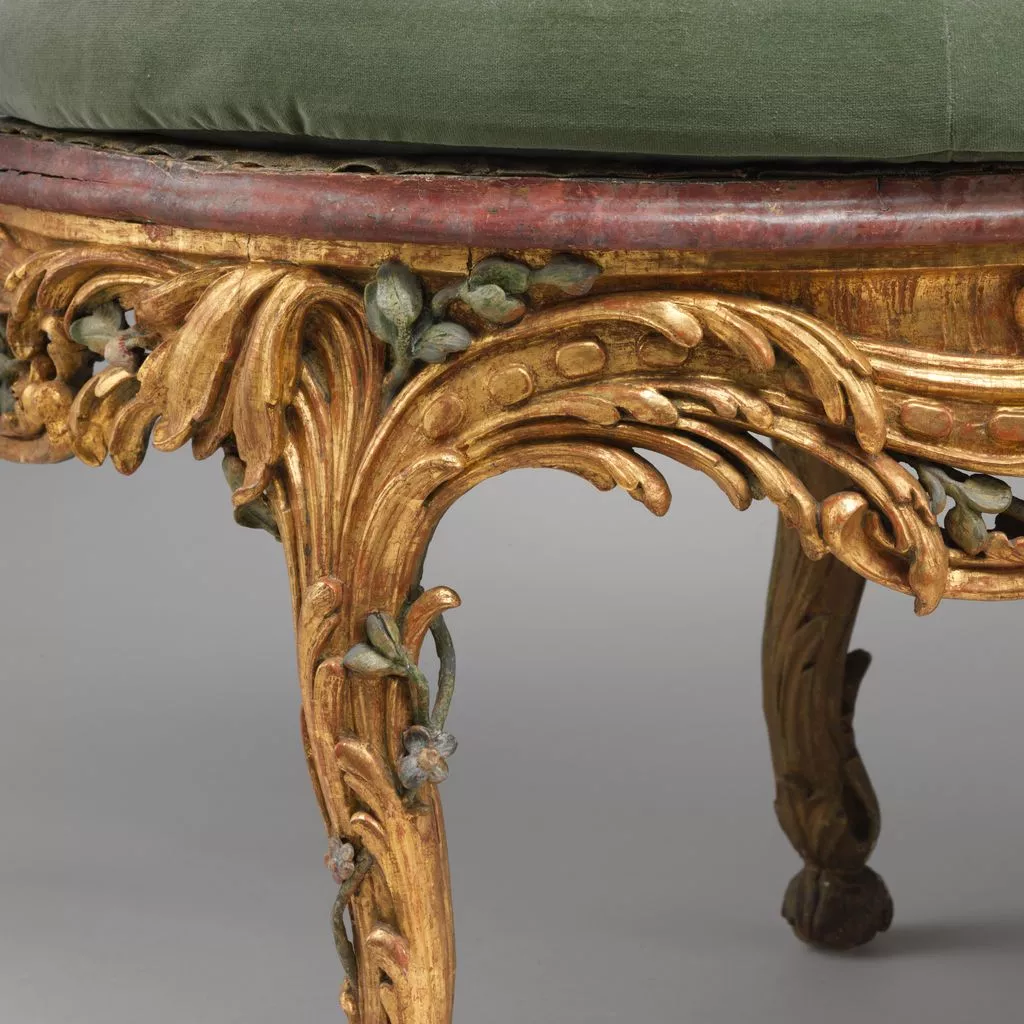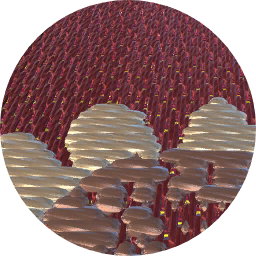Description
Part of a larger set, this remarkable corner settee and its pair, also in the Museum, were commissioned by one of the most powerful figures in eighteenth-century Franconia, Adam Friedrich von Seinsheim (1708–1779). Prince-bishop of Würzburg and, after 1757, also of Bamberg, Seinsheim divided his time between two official residences in those cities and his three summer castles, Veitschöchheim, Werneck, and Seehof.[1] Preferring the country to the city, Seinsheim spent about three months a year outside Bamberg, at Seehof, where he enjoyed walking and hunting. He was fond of gardens and did much to embellish the late-seventeenth-century castle and especially its park, where he ordered that a maze, a theater, and a cascade with grotto and trelliswork arcades be constructed.In 1761 he also resumed work on one of the ancillary buildings at Seehof, the Franckenstein Schlösschen. This garden pavilion at the east end of the orangery and greenhouses had been conceived as a place where the prince could retreat from the strict etiquette at his court. Built by the architect Johann Jakob Michael Küchel (1703–1769) for one of Seinsheim's predecessors, Johann Philipp Anton von Franckenstein, prince-bishop from 1746 to 1753, the Schlösschen had been left unfinished at the time of Franckenstein's death. Contemporary records indicate that Seinsheim decided to have its two main rooms, the Saal and the Audience Chamber (also called the Arbor Room, or berceau), embellished with frescoes and stuccowork. All four walls of the Audience Chamber were to be decorated as an illusionary arbor with trelliswork and floral festoons. Franz Anton Ermeltraut, court painter at Würzburg, was commissioned to execute a small trompe l'oeil ceiling fresco. It is not known when this was finished because the work was delayed by occasional disputes between the patron and the painter and the latter's frequent illnesses.[2] No description of the room's interior was made when the Franckenstein Pavilion was demolished in the nineteenth century, but a drawing thought to be Ermeltraut's design for the Arbor Room has been preserved, illustrating its intended decoration.[3] Also, an inventory of 1774 at Schloss Seehof mentions a "Grünes Perceau-zimmer," or Green Trelliswork Room, in the garden pavilion, showing that the room had been completed by then as planned.Among the furnishings listed were the two settees, together with a pair of matching armchairs and four side chairs that are also in the Museum's collection.[5] In addition, there were four wall brackets hanging in niches, two of which have been preserved as well.[6] These furnishings were described as "von bildhauer Arbeith grün Lassirt," or carved and glazed green.Both the settees and the matching chairs have serpentine gilded frames consisting of large scrolls of various shapes and openwork aprons decorated with polychrome flowers and foliage. They are supported on slightly curved legs carved with a pattern of reeds, and rest on bun feet that are partly covered by foliage. Most unusual is the off-white studded latticework intertwined with gilded and painted foliage on the inner backs of the seats; this must have been in total harmony with the original setting of the furniture. The outer backs of the settees and armchairs were left unfinished, as they were intended to stand against the wall; the side chairs, however, have latticework carving on both sides and were meant to be seen in the round. Corresponding to the inventory description of 1774, traces of a green glaze, originally applied over the gilding, are still present on the furniture.[7] Subsequent inventories offer additional details about the pieces, mentioning their green silk-velvet seat cushions and their placement.[8] Being rather top-heavy and unsteady, the settees stood in two corners of the room and the armchairs are described as being fastened in the other two. Grooves in the outer backs of the settees seem to imply that they too were once secured to the walls of the room.It is, unfortunately, not known who was the maker of this unique garden-room furniture so expressive of the exuberant Rococo taste. Its sculptural silhouette and elaborate carving, the choice of linden wood, and the unusual construction and simple joinery all make it seem likely that a sculptor or master carver rather than a cabinetmaker was responsible for the set.[9] It has been suggested that Margravine Sophie Caroline von Braunschweig-Wolfenbüttel (1737–1817), of neighboring Bayreuth, presented the suite to Seinsheim.[10] This would explain the absence of bills in Seehof's archival records. The margravine is known to have visited Seinsheim regularly, and pieces of furniture were occasionally exchanged between them. Also in favor of a Bayreuth provenance is the florid style of the pieces: Rococo furniture of Bayreuth was characterized by unrestricted use of naturalistic motifs, such as flowers, foliage, reeds, and birds. There was also a preference in Bayreuth for naturalism in interiors. Several rooms in the more recent of Bayreuth's two castles, the Neues Schloss, were decorated before 1760 in imitation of latticework pavilions, the first examples of their kind in Germany.[11] A complete set of furniture would have been an unusually large gift, however. Since the Museum's suite was in such perfect harmony with its original setting, and given Seinsheim's attention to the smallest details of Seehof's embellishments, it seems more likely that the prince-bishop ordered it himself. With the exception of a corner settee in the Würzburg Residenz, no other pieces known today bear even the slightest resemblance to the Seehof set.[12] For this reason, and in the absence of contemporary documents, it is impossible to attribute the furniture to a specific artist.The settees, chairs, and wall brackets presumably remained in the Franckenstein Pavilion until it was pulled down, between 1867 and 1870, and were then transferred to the castle itself. Seehof, which was in the possession of the bishopric and then part of the Bavarian royal domain until 1842, had become the private property of Freiherr Friedrich von Zandt and his descendants. Photographs taken at the turn of the century and later show the furniture in the Zandt family dining room.[13] They indicate that large carved flowers, now missing, originally adorned the cresting of the frames. The castle survived World War II intact, but the interior furnishings were sold off after the death in 1951 of the last male heir of the Zandt family.[14] In 1956 the Munich antiques dealer Fischer-Böhler sold this exceptional seat furniture to the New York collector Emma A. Sheafer. At that time the chairs and settees were upholstered in eighteenth-century painted Chinese silk, and only the trelliswork carving on the outer backs of the side chairs was left uncovered. Mrs. Sheafer never knew the full splendor of the furniture that filled the dining room of her New York City apartment. It was with their painted silk show covers that the furniture came to the Museum as part of her bequest in 1973. Once the fabric had been taken off, a conservation campaign was undertaken. This included the reconstruction of the foliage around the inner edge of the frames, which had been cut away to accommodate the upholstery; the removal of later paint layers on the trelliswork; and the manufacture of seat cushions covered in velvet to match the originals.[15][Daniëlle Kisluk-Grosheide 2006]Footnotes:[1] Much of the information in this entry is taken from Kisluk-Grosheide 1990. See also Sangl 1990, pp. 215–21.[2] Masching 1996, pp. 19–20, A9, p. 23, A16.[3] Roda 1990, pp. 161–68, fig. 3.[4] Staatsarchiv Bamberg, Rep. B24, no. 756, fol. 139.[5] The accession numbers of the pair to the present settee, of the armchairs, and of the four side chairs are, respectively, 1974.356.121; 1974.356.118, .119; and 1974.356.114–.117.[6] Accession numbers 1974.356.123, .124. They were originally fitted on top with vase-shaped carvings, which are now in the collection of the Bayerische Verwaltung der Staatlichen Schlösser, Gärten und Seen, Munich. The other two brackets and their tops were most likely used to construct a late-nineteenth-century center table to match the seat furniture. This table, which is also in the Museum's collection (acc. no. 1974.356.122), is on long-term loan to Schloss Seehof.[7] Copper was used for this glaze, which would have been applied in a variety of transparent-to-opaque green tones that would allow the gilding to partially shine through. See Gill, Soultanian, and Wilmering 1990, pp. 171–72.[8] See the inventories of 1802, room 57B, and 1817–18, p. 37, no. 2A, transcripts of which are kept in the archives at Schloss Seehof.[9] Linden wood was more often used for sculpture than for furniture during this period. Unusual also is the way that the chairs were constructed. Normally the back supports would have formed one piece with the back legs. Here they were made like stools, with the backs attached separately. See Gill, Soultanian, and Wilmering 1990, p. 169.[10] This was suggested by the Munich dealer Fischer-Böhler.[11] Kisluk-Grosheide 1990, pp. 156–57, fig. 23.[12] Heinrich Kreisel attributed the Würzburg settee to Johann Köhler, an otherwise unknown sculptor, who was paid for "sculptural work [and/or] carving executed in the newly furnished chamber in the princely residence"; Kreisel 1930, pp. 29–30. He ascribed the Seehof set to Köhler, as well; Kreisel 1956, pp. 20–21, 34, n. 28, 38–39, fig. 23.[13] Kisluk-Grosheide 1990, p. 152, figs. 15, 16; and Masching 1991, pp. 67–68, 92, figs. 17, 18.[14] Freiherr Franz Joseph von Zandt died in 1951. His widow remarried the following year, and the Zandt-Hessberg'sche Verwaltung assumed management of the castle; Masching 1991, pp. 68, 77, n. 13.[15] For a description of this conservation work, see Gill, Soultanian, and Wilmering 1990.












